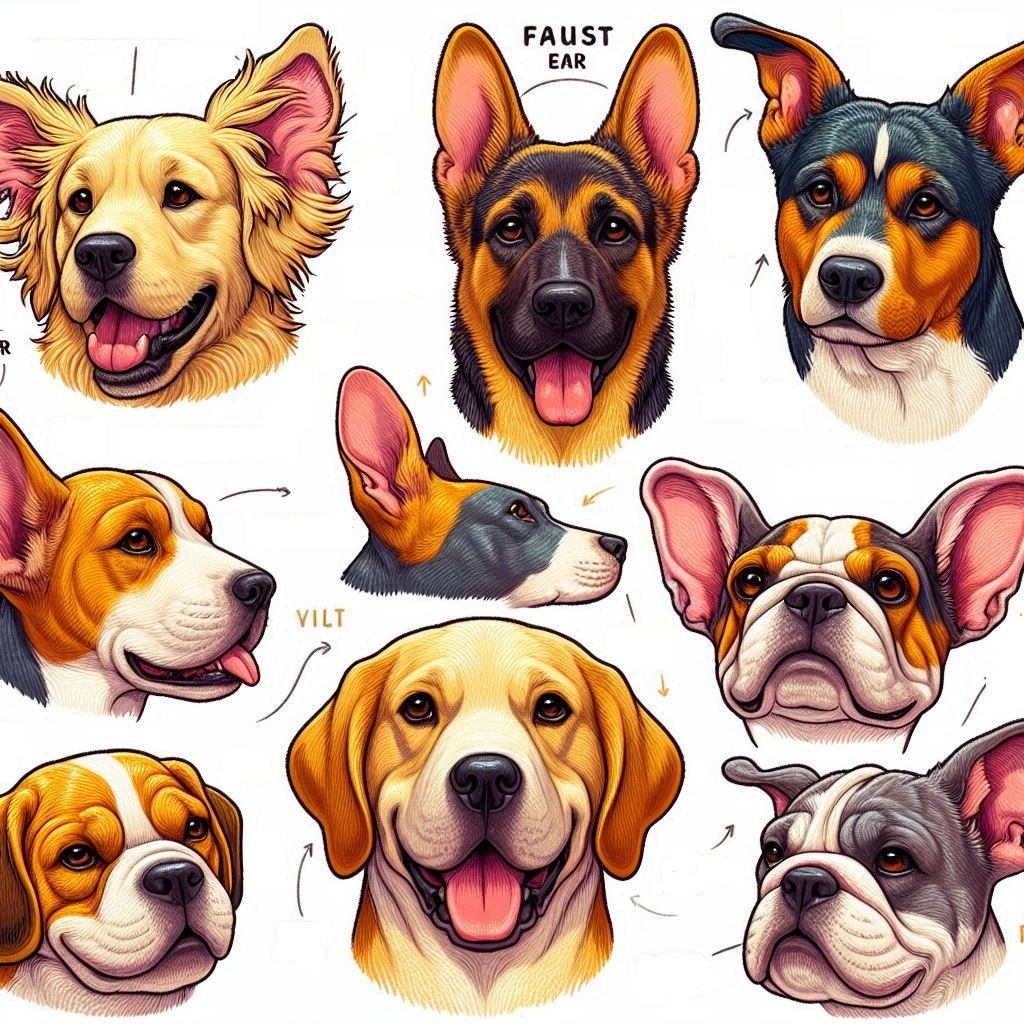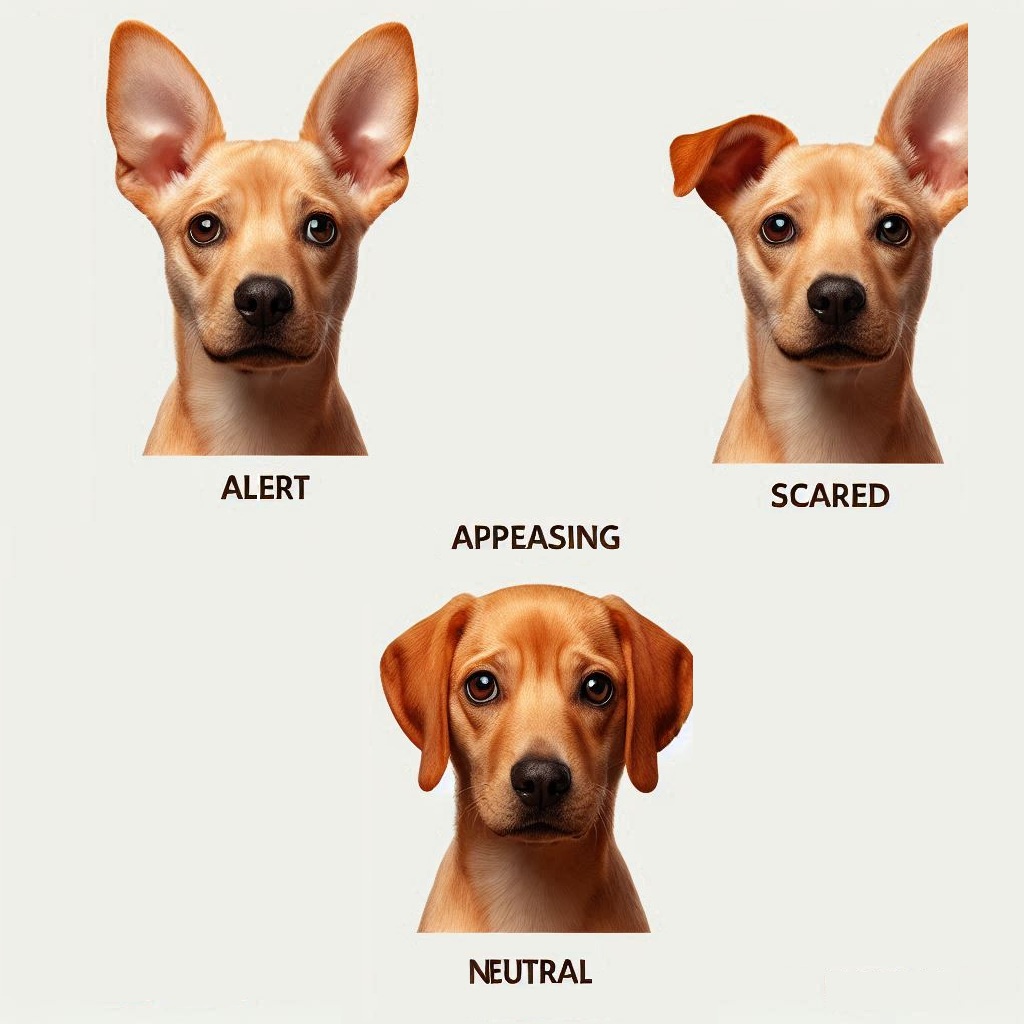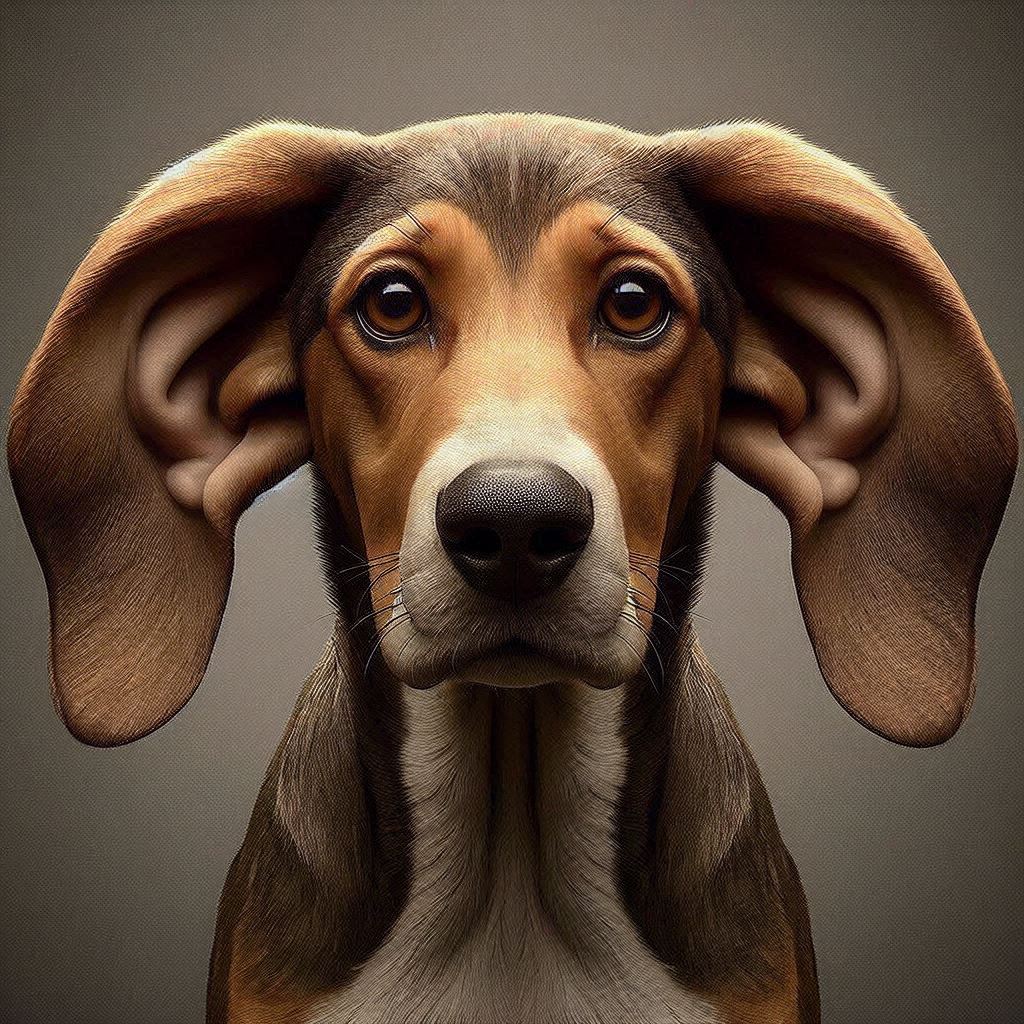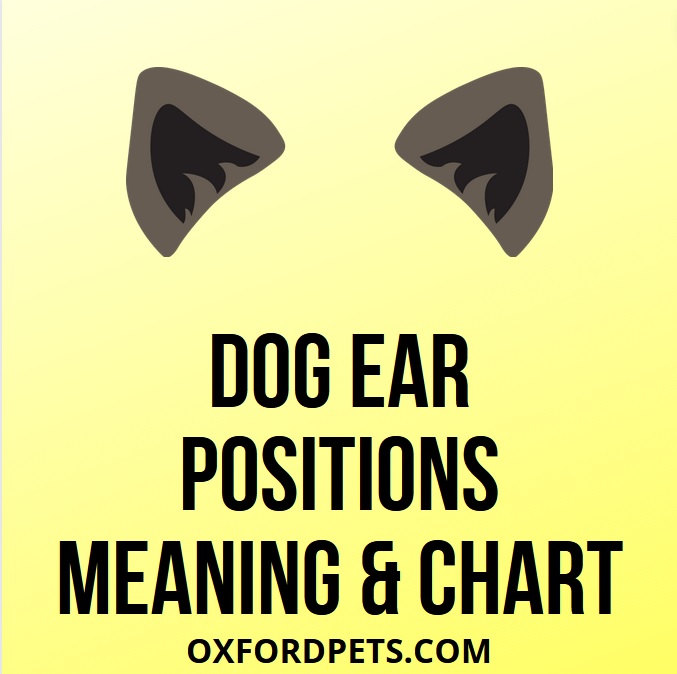Wondering, What does Your Dog’s Ear Position mean? Understanding Your Dog’s Ears Positions Language and Signs is difficult to know what your pooch is thinking. However, by looking at its ear positions, you can tell what is in your canine’s thoughts. Whether it is drooping down or perking up, there are many facts about ear positions. Every canine has different ear sizes and relevant positions for the different things they might feel.
Let’s dive deeper into each dog ear position and elaborate further on the emotions or intentions behind them. Understanding subtle variations can help you better connect with and respond to your furry friend:

Contents
- General Meaning Of Dogs Ear Positions
- Explanation For Each Dog Ear Positions
- 1. Erect Ears
- 2. Half-Erect Ears
- 3. Folded-Back Ears
- 4. One Ear Up, One Ear Down
- 5. Droopy Ears
- 6. Pricked Ears
- 7. Relaxed Ears
- 8. Rotated or Tilted Ears
- 9. Raised Hackles with Ears Back
- 10. Tucked Ears
- 11. Alert Ears
- 12. Folded Forward Ears
- 13. Backward-Facing Ears
- 14. Perked-Up Ears with a Relaxed Body
- 15. Ears Pulled Back with Exposed Teeth
- Breakdown of Dog Breeds With Various Ear Positions
- 1. Erect Ears
- 2. Half-Erect Ears
- 3. Folded-Back Ears
- 4. One Ear Up, One Ear Down
- 5. Droopy Ears
- 6. Pricked Ears
- 7. Relaxed Ears
- 8. Rotated or Tilted Ears
- 9. Raised Hackles with Ears Back
- 10. Tucked Ears
- 11. Alert Ears
- 12. Folded Forward Ears
- 13. Backward-Facing Ears
- 14. Perked-Up Ears with a Relaxed Body
- 15. Ears Pulled Back with Exposed Teeth
- Behavioral Context and Variations Of Dogs
- Dog Body Language Other Than Ears
- Related FAQ’S About Dog Ear Positions
- Why are dos ears so expressive anyway?
- How do dogs express their love?
- What does it mean when a dog’s ears are to the side?
- How do you read a dog’s ears?
- How do I know if my dog’s ears will stand up?
- At what age do puppy ears stand up?
- What does it mean when a dog’s ears are tilted back?
- How do I know my dog is happy?
- How can you tell a dog’s emotions?
- What does it imply when a dog puts one ear up and one ear down?
- What does it mean when a dog’s ears go down when they see you?
- Final words
General Meaning Of Dogs Ear Positions
Each of these ear positions can vary slightly depending on the breed and the context. Understanding ear positions alongside other cues like tail posture and facial expressions can give you a more complete picture of your dog’s feelings and intentions.
1. Sign of Insecurity
- Ear Position: Ears pulled back or tucked tightly against the head.
- Meaning: The dog might feel fearful, uneasy, or uncertain about their surroundings or a particular situation. They could also look for reassurance through other submissive behaviors like avoiding eye contact or crouching.
2. Sign of Concentration or Deep Thoughts
- Ear Position: Erect or pricked ears slightly angled forward.
- Meaning: When a dog is deeply focused on a sound, scent, or activity, their ears stand at attention to gather as much information as possible. Their body often remains still while they concentrate.
3. Just Finished Something
- Ear Position: Relaxed or drooping ears.
- Meaning: After completing an activity like playing, eating, or exercising, dogs will often display relaxed ear positions as they wind down or take a break.
4. Have an Idea of Doing Something
- Ear Position: Ears perked forward, with quick, responsive movements.
- Meaning: This can indicate that the dog is alert and planning their next action, like chasing a ball, exploring an object, or initiating play.
5. Need Sympathy
- Ear Position: Folded-back or lowered ears, combined with soft, pleading eyes.
- Meaning: When a dog is seeking comfort or reassurance, they may pull their ears back gently and look at you with an expression that communicates vulnerability.
6. Daydreaming
- Ear Position: Ears in a neutral or slightly droopy position.
- Meaning: When a dog is relaxed and content, possibly gazing off into the distance, their ears remain loose and natural. This state shows they are at ease and enjoying a peaceful moment.
Explanation For Each Dog Ear Positions

1. Erect Ears
- Description: The ears are fully upright, standing tall and pointed. In breeds with naturally floppy ears, this may mean partial lifting of the ear base.
- Emotion/Meaning: This position signifies that the dog is highly alert, attentive, or on guard. It’s often seen in situations where the dog is monitoring their surroundings, such as detecting a sound or spotting movement. Dogs in this position are ready to respond to whatever has caught their attention.
- Scenario: A dog hears a distant noise or sees someone approaching their territory.
2. Half-Erect Ears
- Description: Ears are partially raised but not fully upright; they may tilt slightly outward or forward.
- Emotion/Meaning: This indicates curiosity or mild interest. The dog is investigating or exploring without being overly excited or tense.
- Scenario: A dog encountering a new toy or sniffing around in a new environment.
3. Folded-Back Ears
- Description: Ears are pulled backward and close to the head, appearing flattened.
- Emotion/Meaning: A sign of fear, anxiety, or submission. Dogs often adopt this position when they feel threatened or when interacting with a dominant dog or person. This can also signal discomfort or uncertainty in their environment.
- Scenario: A dog at the vet’s office or meeting a new dog that intimidates them.

4. One Ear Up, One Ear Down
- Description: One ear is held upright, while the other is relaxed or folded.
- Emotion/Meaning: This position shows mixed feelings or playfulness. It may indicate a relaxed mood, but with some attentiveness to the surroundings. It can also suggest uncertainty or hesitation in assessing a situation.
- Scenario: A dog playing and pausing to assess how their playmate will respond.

5. Droopy Ears
- Description: The ears hang loosely and appear relaxed, even in breeds with naturally erect ears.
- Emotion/Meaning: This signifies that the dog is feeling relaxed, content, or even tired. It’s commonly observed when the dog is resting, feeling secure, or simply calm in the moment.
- Scenario: A dog lounging at home or snoozing after a meal.
6. Pricked Ears
- Description: Ears are sharply pointed forward, directed toward a stimulus.
- Emotion/Meaning: Dogs in this position are showing excitement or intense interest. They are focused on a specific sound, sight, or object and are likely to act on it, whether it’s chasing, playing, or investigating.
- Scenario: A dog notices a treat jar opening or hears a doorbell.
7. Relaxed Ears
- Description: Ears are loosely held in their natural position without tension.
- Emotion/Meaning: This reflects calmness and happiness. It’s a sign of a dog that feels safe, either while resting or enjoying gentle interaction with their human.
- Scenario: A dog lying on their owner’s lap during a quiet evening.

8. Rotated or Tilted Ears
- Description: Ears are rotated backward, forward, or at an angle, often independently of each other.
- Emotion/Meaning: This often indicates playfulness, curiosity, or caution. Dogs may move their ears in different directions to better detect sounds or signal their mood through body language.
- Scenario: A dog tilting its ears and wagging its tail while inviting playtime.
9. Raised Hackles with Ears Back
- Description: The ears are pulled back, and the fur along the dog’s back and neck (hackles) is raised.
- Emotion/Meaning: A sign of fear, defensiveness, or aggression. Raised hackles are an involuntary response and indicate heightened arousal or stress. The ears being back show that the dog is feeling threatened or cornered.
- Scenario: A dog encountering a stranger or another animal they perceive as a threat.
10. Tucked Ears
- Description: Ears are tucked tightly against the head and appear pinned down.
- Emotion/Meaning: Dogs adopt this position when experiencing extreme fear, anxiety, or physical pain. It’s a submissive gesture that can also indicate distress.
- Scenario: A dog being scolded or facing an overwhelming situation.
11. Alert Ears
- Description: Ears are perked up and directed forward with precise focus.
- Emotion/Meaning: This signifies heightened vigilance and awareness. Dogs in this position are actively monitoring their environment and prepared to act quickly if needed.
- Scenario: A guard dog patrolling their area or a hunting dog tracking prey.

12. Folded Forward Ears
- Description: Ears are folded or slightly drooped toward the front.
- Emotion/Meaning: Dogs with this position may be curious or interested in something specific. The forward angle indicates focus or attention.
- Scenario: A dog sniffing an unfamiliar object or listening to a sound closely.
13. Backward-Facing Ears
- Description: Ears are pulled backward but not pinned flat to the head.
- Emotion/Meaning: This can indicate submission, fear, or discomfort. The degree of tension in the ears and the dog’s overall body language will give further insight into whether this is mild nervousness or greater fear.
- Scenario: A dog meeting a dominant individual or being approached in an unfamiliar environment.
14. Perked-Up Ears with a Relaxed Body
- Description: Ears are pointed upright, but the rest of the body is loose and relaxed.
- Emotion/Meaning: This reflects mild excitement or interest, without stress. The dog is engaged but remains calm and happy.
- Scenario: A dog waiting for their owner to throw a ball or hand them a treat.

15. Ears Pulled Back with Exposed Teeth
- Description: Ears are pinned back tightly while the dog bares their teeth.
- Emotion/Meaning: This is a clear sign of aggression or defense. It serves as a warning for others to back off as the dog is preparing to act if necessary.
- Scenario: A dog guarding a valuable resource or responding to a perceived intruder.
Breakdown of Dog Breeds With Various Ear Positions
Dogs across all breeds can exhibit variations of the ear positions mentioned earlier, but their physical ear structure plays a role in how these positions are expressed. Here’s a breakdown of types of dogs are most likely to demonstrate each ear position, based on their ear shapes and breeds:
1. Erect Ears
- Breeds: German Shepherds, Huskies, Doberman Pinschers, and Belgian Malinois.
- Traits: Dogs with naturally upright, pointy ears are the most visually expressive in this position.
2. Half-Erect Ears
- Breeds: Border Collies, Australian Shepherds, and Shetland Sheepdogs.
- Traits: Breeds with semi-pricked ears commonly show this position when they’re curious.
3. Folded-Back Ears
- Breeds: Golden Retrievers, Labrador Retrievers, and Beagles.
- Traits: Dogs with medium to floppy ears often display this position during submissive or anxious situations.
4. One Ear Up, One Ear Down
- Breeds: Mixed breeds, Jack Russell Terriers, and Corgis.
- Traits: This quirky position can happen with dogs that have asymmetric or naturally floppy ears.
5. Droopy Ears
- Breeds: Basset Hounds, Bloodhounds, and Cocker Spaniels.
- Traits: Breeds with long, floppy ears naturally show this position, but it can also occur when relaxed.
6. Pricked Ears
- Breeds: Basenjis, Chihuahuas, and Shiba Inus.
- Traits: Small to medium-sized dogs with upright ears express excitement and interest this way.
7. Relaxed Ears
- Breeds: Most breeds, including Bulldogs, Pugs, and Dalmatians.
- Traits: This is a universal position across all breeds when dogs are at ease.
8. Rotated or Tilted Ears
- Breeds: All breeds, especially those with active, mobile ear muscles like Papillons and Collies.
- Traits: Dogs who are highly attentive and expressive often show ear rotation when curious.
9. Raised Hackles with Ears Back
- Breeds: Rottweilers, Akitas, and German Shepherds.
- Traits: Breeds with a protective or guarding instinct often display this posture when threatened.
10. Tucked Ears
- Breeds: Italian Greyhounds, Whippets, and Cavaliers.
- Traits: Breeds prone to timid or sensitive behaviors may often tuck their ears when overwhelmed.
11. Alert Ears
- Breeds: Alaskan Malamutes, Fox Terriers, and Miniature Pinschers.
- Traits: High-alert breeds with upright ears make this position very prominent.
12. Folded Forward Ears
- Breeds: Labradoodles, Cockapoos, and Sheepadoodles.
- Traits: Dogs with soft, floppy ears often fold them slightly forward when curious.
13. Backward-Facing Ears
- Breeds: Dachshunds, Chow Chows, and Mixed Breeds.
- Traits: Dogs communicating fear or submissiveness from various breeds will show this.
14. Perked-Up Ears with a Relaxed Body
- Breeds: Great Danes, Irish Setters, and Rhodesian Ridgebacks.
- Traits: Larger breeds with erect ears and calm dispositions commonly show this mix of attention and ease.
15. Ears Pulled Back with Exposed Teeth
- Breeds: Pit Bulls, Bull Terriers, and Cane Corsos.
- Traits: Dogs with strong protective instincts display this position when showing aggression or defensiveness.
These positions occur across all breeds, but the specific structure and mobility of the ears (upright, semi-floppy, or fully floppy) influence how prominently these expressions are seen. It’s always essential to combine ear positions with overall body language for a comprehensive understanding of your dog’s emotions. Let me know if you’d like detailed advice tailored to a specific breed!
Behavioral Context and Variations Of Dogs
Understanding your dog’s ear positions alongside their overall body language adds vital context. For example:
- A low tail or hunched posture often amplifies signs of insecurity or a need for sympathy.
- Alert eyes combined with ears pricked forward show intense concentration or anticipation.
- A wagging tail paired with folded-back ears might mean playful submission rather than fear.
By learning these nuances, you can better empathize with your dog’s emotional states and respond in ways that make them feel understood and cared for.
Dog Body Language Other Than Ears
Dogs communicate a lot through their body language, and paying attention to their posture, tail movement, eyes, and even their overall demeanor can give you valuable insights into their feelings. Here’s a breakdown of key signals beyond just their ears:
1. Tail
- Wagging high and fast: Excitement or happiness.
- Low wagging: Submissive or uncertain.
- Tucked between legs: Fear, anxiety, or stress.
- Held stiff and upright: Alertness or aggression.
2. Eyes
- Soft, relaxed gaze: Contentment and friendliness.
- Avoiding eye contact: Submission or fear.
- Wide eyes (whites of the eyes visible, aka “whale eye”): Stress or discomfort.
- Direct stare: Can indicate a challenge or confidence (context-dependent).
3. Mouth
- Relaxed, slightly open mouth: Calm and happy.
- Lips pulled back with teeth showing (not snarling): Stress or anxiety.
- Snarling (teeth bared): Warning or aggression.
- Yawning: Can be a sign of stress or an attempt to calm themselves in an uncomfortable situation.
4. Body Posture
- Loose, wiggly body: Friendly and playful.
- Stiff or frozen posture: Fear or aggression.
- Crouching or lowering body: Submission or fear.
- Play bow (front legs down, rear up): An invitation to play.
5. Paws
- Pawing at you gently: Seeking attention or interaction.
- Lifting one paw while sitting or standing: Curiosity or uncertainty.
6. Vocalizations (Bonus!)
- Whining, barking, or growling all have distinct meanings depending on pitch, intensity, and situation.
Dogs are experts in non-verbal communication, and they often combine multiple signals to express themselves. Observing context and their usual behavior helps decode their feelings more effectively.
Related FAQ’S About Dog Ear Positions
Why are dos ears so expressive anyway?
A canine’s ears are very expressive because –
- The ears help the canine communicate
- Express anger, fear, happiness, etc.
- The shape of the ears tells about a dog’s breed
- Ears act as a protective shield against wind and sun
- Canines have a great sense of hearing
How do dogs express their love?
Your canine may bounce at you, and lick your face. Additionally, they may simply wag their tail. Being excited and glad to look at you is one way you may be confident they love and miss you. They are looking for bodily contact. This can come in the form of a cuddle, or the lean.
What does it mean when a dog’s ears are to the side?
The most common position your canine’s ears should be in is the neutral place. This is when they may be angled to the side, not pricked ahead. They additionally do not slump or pull flat against the head. This is an indication that your canine is comfortable and taking it easy.
How do you read a dog’s ears?
As a standard rule, a canine’s degree of attention can be decided by looking at their ears: Erect ears facing ahead imply that they may be engaged, and barely pulled-back ears signal that they may be feeling friendly; however canine ears laid tightly back against the head advise an apprehensive or timid reaction.
How do I know if my dog’s ears will stand up?
A top-notch manner to test is to call your pup or make a sound that receives their attention. If the ears perk up in a way that indicates they may be looking to stand, there is a great chance they may go up over time.
At what age do puppy ears stand up?
A pup’s ears standing is an extraordinarily sluggish procedure that develops over time. It normally starts about 2 to 3 weeks after birth and may take as much as 7 or 8 months to stand absolutely upright.
What does it mean when a dog’s ears are tilted back?
When puppies pin their ears back or flatten them in opposition to their head, this will represent that the canine feels submissive, afraid, or anxious. The flattened position is a protective role for puppies, and the tighter he holds his ears back in opposition to his head, the more anxious he is.
How do I know my dog is happy?
When a canine is happy, its complete body and tail will look comfortable, and they wiggle pretty regularly! A satisfied canine’s whole body can wag along with its tail. A wriggling canine showing you its stomach is probably to be a completely happy and snug canine.
How can you tell a dog’s emotions?
Canines with their tails pointing down to the floor or maybe tucked among their legs are feeling worried and stressed. Canines with their tails held up are feeling confident, possibly even aggressive. Relaxed canines keep their tails in a neutral function, however neutral relies upon the breed.
What does it imply when a dog puts one ear up and one ear down?
Erect ears may want to imply that your canine is listening carefully and is in an alert position. On the other hand, pinned-back ears imply worry or intimidation. Combining both, one ear up and one ear down probably means that your canine is cautiously curious.
What does it mean when a dog’s ears go down when they see you?
Ears down and at the lower back means your canine is being submissive. Also, this means that they’re ready to be petted. But while ears are down and different body signals, consisting of bared teeth, are present, it may be a signal that your canine senses threat and is ready to enter defense mode.
- HELPS ALLEVIATE – This dog and cat ear cleaner was formulated with properties to help promote healthy ear canals. Rinse pet’s ears daily with solution and massage area.
- DAILY MAINTENANCE – Helps breakdown buildup in the canal that may be causing foul odors and itching, scratching, and head shaking. Excellent for daily care and
- GENTLE FOR SENSITIVE EARS – Alcohol-free, mildly scented, and a non-irritating formula, this cat and dog ear wash is suitable for sensitive ears and gentle enough for frequent use.
- FOR YOUR PETS – Clinical Care Ear Therapy is great for dogs, cats, and small animals over 12 weeks for daily care and to maintain the ear health of your pet.
- EFFECTIVE & AFFORDABLE – Our premium products are high-quality at an affordable price. Store original container in a cool, dry place away from the sun, below 86°F or 30°C.
- Advanced Formulation Designed to Gently Clean, Deodorize and Dry Your Pets Ears
- Gentle and Safe for Regular Use which Prevents Ear Infections, Reduces Wax Build Up and Removes Debris in and Around the Ear
- 100 Convenient, Soothing and Non-Irritating Disposable Ear Wipes for Dogs. For Dogs Over 12 Weeks Old
- Reduce Foul Ear Odor and Prevents Infection to Keeps Your Dog Happy and Healthy without Medication
- Made in the USA in Federally Regulated Manufacturing Facilities to Ensure Quality and Safety
- MADE FOR GROOMERS, BY GROOMERS. Happy Hoodie was created as a grooming tool to CALM & protect dogs from the loud noise & high-pressured air associated w/ force drying. Happy Hoodie saves valuable time in the Grooming Salon & creates a safer environment by calming upset, disagreeable, aggressive, or sensitive dogs during any potentially stressful situation, such as toenail clipping, clipper work, brushing, bathing, etc. The dog anxiety calming aid you want to have in your dog grooming tool kit.
- HOW TO REDUCE NOISE. It is important to place the ears DOWN over the ear canals so the ear canals are NOT exposed, then secure them in place w/ Happy Hoodie. Noise reduction is achieved by Happy Hoodie’s gentle compression closing off the ear canal. IF YOU THINK IT’S TOO TIGHT, PLEASE KNOW SNUGNESS IS NECESSARY. IF YOUR 4 FINGERS FIT UNDER IT, IT’S NOT TOO TIGHT (IT’S SO STRETCHY!). Pets appreciate it most when used ONLY during a stressful situation. PLEASE REFER TO SIZE GUIDE BEFORE PURCHASE.
- HELPS KEEP PETS CALM AND COMFORTABLE AT HOME TOO! Uses include: Anti-anxiety aid for stress in the home, car, and at the Vets; dog ear muffs for noise cancelling to protect dogs’ ears and hearing from loud noise, such as Thunder, Fireworks, vacuums, and gun fire; aerate the ears; heal or prevent hematomas; neck and ear warmers; grooming aid; keeping long ear and facial hair up and out of the way while eating or drinking.
- RECOMMENDED BY VETS to help prevent or heal hematomas when used as a dog ear wrap for shaking heads, help control bleeding; aerate the ears to speed up recovery of an ear infection; keep medication from being shaken out of ears; provide dog ear protection for swimming and bath time; as a post-surgery ear protection aid.
- A NATURAL, HOMEOPATHIC DOG CALMING REMEDY SINCE 2008, its swaddling effect will soothe and comfort pets. When worn together, Happy Hoodie can increase and complement the efficiency of dog anxiety vests, fireworks and separation anxiety jacket, stress collars, calming scarf, or thunder hoody or shirt for dogs. It may also be used in conjunction with oral calming remedies.
- MADE FOR GROOMERS, BY GROOMERS. Happy Hoodie was created as a grooming tool to CALM & protect dogs from the loud noise & high-pressured air associated w/ force drying. Happy Hoodie saves valuable time in the Grooming Salon & creates a safer environment by calming upset, disagreeable, aggressive, or sensitive dogs during any potentially stressful situation, such as toenail clipping, clipper work, brushing, bathing, etc. The dog anxiety calming aid you want to have in your dog grooming tool kit.
- HOW TO REDUCE NOISE. It is important to place the ears DOWN over the ear canals so the ear canals are NOT exposed, then secure them in place w/ Happy Hoodie. Noise reduction is achieved by Happy Hoodie’s gentle compression closing off the ear canal. IF YOU THINK IT’S TOO TIGHT, PLEASE KNOW SNUGNESS IS NECESSARY. IF YOUR 4 FINGERS FIT UNDER IT, IT’S NOT TOO TIGHT (IT’S SO STRETCHY!). Pets appreciate it most when used ONLY during a stressful situation. PLEASE REFER TO SIZE GUIDE BEFORE PURCHASE.
- HELPS KEEP PETS CALM AND COMFORTABLE AT HOME TOO! Uses include: Anti-anxiety aid for stress in the home, car, and at the Vets; dog ear muffs for noise cancelling to protect dogs’ ears and hearing from loud noise, such as Thunder, Fireworks, vacuums, and gun fire; aerate the ears; heal or prevent hematomas; neck and ear warmers; grooming aid; keeping long ear and facial hair up and out of the way while eating or drinking.
- RECOMMENDED BY VETS to help prevent or heal hematomas when used as a dog ear wrap for shaking heads, help control bleeding; aerate the ears to speed up recovery of an ear infection; keep medication from being shaken out of ears; provide dog ear protection for swimming and bath time; as a post-surgery ear protection aid.
- A NATURAL, HOMEOPATHIC DOG CALMING REMEDY SINCE 2008, its swaddling effect will soothe and comfort pets. When worn together, Happy Hoodie can increase and complement the efficiency of dog anxiety vests, fireworks and separation anxiety jacket, stress collars, calming scarf, or thunder hoody or shirt for dogs. It may also be used in conjunction with oral calming remedies.
Final words
Your canines’ ears are very capable of communicating and listening. With main behaviours and emotions being consistent in all breeds, you can know what your dog needs or wants in a specific situation. The standard ear positions vary from neutral to fearful. Your canines have a lot of emotions in them. Cropping Dog ears has become quiet a culture among many dog lovers but it depends on which breed you’re going for such as Dobermans.
I have listed the most common dog ear positions and their meaning. As a responsible dog owner, you must know what your canine is trying to tell you.




